| Lot |
Photo |
Description |
Realized |
Lot 1002 |
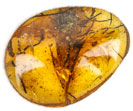 |
Rare Feather (Possibly Dinosaur) in 100 Million Year Old Amber. Rare, 30 x 23 mm golden yellow Burmite amber nugget contains a large complete 22 mm possible dinosaur feather. This large branching symmetric feather is beautifully preserved with a central rachis. Being symmetric this is not a flight feather but rather is a feather from the body or arm of a 100 million year old dinosaur or bird. This feather has remarkable detail and appears to have some feather pigment still present. This pigment is brown or perhaps brown with black in color, extremely rare in amber as almost all of the specimens have the color completely bleached out leaving just a golden color. This rare and important feather is one of the largest and best preserved feathers found in Burmite amber. Presented in a 8 x 6" Riker mount with an enlarged photo of the dinosaur/bird feather. $3,000 - 4,000
View details and enlarged photo
| Unsold |
Lot 1003 |
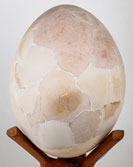 |
Largest Egg Known. The extinct flightless bird Aepyornis maximus produced the largest egg of any animal that ever lived including dinosaurs. This egg is 13 inches high and 9.5 inches high. Aepyornis is commonly known as the elephant bird, a name that originated from Marco Polo's account of the giant bird in 1298. Aepyornis only lived on the island of Madagascar and the pieces of original shell from this bird have been reconstructed to form this huge impressive egg. The fossil shell is 10,000-20,000 years old and was found in the southern sands of Madagascar. Great care and time was spent in matching the sizes, curvature, and color of the egg fragments to put the egg back to its normal shape and size. This egg is a cream to light tan color with more than 65% of the egg fragments from the same egg and most of the remaining shell from one other egg. The egg is quite solid and stable. There are only about a dozen unbroken Aepyornis eggs known, most in museums with one selling at auction for over $35,000. This huge egg comes perched on a hand carved wooden stand. $2,500
View details and enlarged photo
| Realized
$1,740 |
Lot 1004 |
 |
280 Million Year Old Amphibian and Fish. On a 16 x 12" matrix, a 280 million year old remarkably well preserved early amphibian, Sclerocephalus hauseri as well as two primitive fish. This rare museum quality early amphibian is over 11 inches long and nearly complete with a well detailed 1¾" wide arrow shaped skull with a lower jaw filled with tiny sharp teeth and detailed light and dark brown patterned skin impressions along the entire body. Only one of the four feet and a few small leg bones and digits are missing. The two primitive fish Paramblypterus sp. are 6 inches and 3½ inches long and preserved with their skin and heterocercal fins that are somewhat shark-like. Skin impressions are rare as they are soft tissue and even the texture of the skin is detectable in these impressive fossils. These museum quality fossils from the Odernheim Pfatz in Germany are rare because the quarry closed in 1984 and in great demand as they only become available when old collections are sold. $2,500 - 3,000
View details and enlarged photo
| Realized
$1,563 |
Lot 1005 |
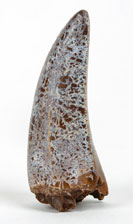 |
Fine Tyrannosaurus Rex Tooth, Butte County, South Dakota. Highly prized and valuable fossilized Tyrannosaurus Rex tooth (Cretaceous period, 65 million years old) from the Hell Creek rock formation in Butte County, South Dakot. Qorld famous as a source of Cretacious era fossils and study location, know all T-Rex teeth are shed teeth except the very few that are found with the dozen or so partial skeletons that have been found. Tooth measures 2 ¾" in length, in fine shape with mottled enamel preservation, very good serrations and with no repairs Comes in 5½ x 4½ Riker mount. with identifying tag. $1,500 - 2,500
Geode Shop of Ghost Town, Buena Park.
View details and enlarged photo
| Realized
$900 |
Lot 1006 |
 |
Partial Lizard in 100 Million Year Old Amber. One of the rarest and most desirable of creatures in amber is that of a lizard. Burmite is 100 million year old amber that is found in the Hukawng Valley of Myanmar (Burma). This remarkable 1 1/8th inch long partial lizard encased in a 1½ x ¾" clear orange colored amber nugget shows most of the body and tail with two leg stubs and a blob of skin where the head should be. Lizards are seldom complete in amber because even though their body is encased in amber which is dessicating, the bacteria contained within their body lives long enough to break down the soft tissue of the lizard's body.
This rare lizard in amber is housed in a 8 x 6" Riker mount with a photo of the lizard. $1,500 - 2,000
View details and enlarged photo
| Unsold |
Lot 1007 |
 |
Skin of Lizard Including Foot in Burmite. Burmite amber from Burma at 100 million years old is some of the oldest and certainly best quality ancient amber found in the world. This remarkable 22 x 13 mm polished piece of clear honey colored amber contains ¾ of the skin of a lizard's body (18mm long) including its tail along with a complete foot. Almost all of the lizard parts found in Burmite are just skin because the bacteria in the lizard's body do not die until they digest the lizard's body. The foot is just bone, skin and claws and is much more resistant to bacterial attack. This is a rare and impressive specimen is preserved in a 8 x 6" Riker mount. $1,400 - 1,700
View details and enlarged photo
| Unsold |
Lot 1008 |
 |
Spectacular Spiny Trilobite. This museum quality and very appealing black trilobite is 1¾" long complete and professionally prepared fully 3-D with the complete body, head with raised eyestalks and each sharp spine exposed. Also, the light gray matrix was cut away and shaped to form a 2 x 1½ " natural base. This impressive display is as close as you can get to seeing a real trilobite. $1,200 - 1,500
View details and enlarged photo
| Unsold |
Lot 1009 |
 |
Complete Large Duckbill Dinosaur Toe. This large 11 inch long outer toe (Digit 4) of the famous Duckbill Dinosaur Edmontosaurus which had only three toes on its hind feet, is complete with just minor crack repairs on two of the phalanges and a chip on the hoof (ungual). Found on a private ranch in the 66-67 million year old Hell Creek Formation of Montana, this large complete toe probably comes from a sub-adult has an excellent tan color and bone quality. The hoof is 3.25 inches long and 3 inches wide which in life would have been webbed skin attached to its base, hence the name Duckbill dinosaur. The hoof is complete except for a � inch chip on the middle of the left side that is barely noticeable from the top side. Edmontosaurus was a plant eating dinosaur and one of T-Rex's favorite food items as well as being one of the last dinosaurs alive that died out when the huge asteroid hit the earth 66 million years ago. $1,100 - 1,500
View details and enlarged photo
| Unsold |
Lot 1010 |
 |
T-Rex Pre-Maxilary Tooth. Almost all T-Rex teeth found were broken off when the T-Rex was feeding on some other dinosaur and are found fragments in many pieces. But this large 1.9 inch Pre-Maxilary tooth is the exception being intact with some cracks and some serrations but no restoration. �" sections of enamel are missing from both the top and bottom of the tooth but is not visible from the side. This light brown tooth is from an adult T-Rex as the pre-maxilary teeth are smaller than the teeth further back in the jaw and were used to strip meat from the bone. They are very distinctive in having two rows of serrations close together on the inner curve of the tooth. This 65 million year old treasure was found on a private ranch in the Hell Creek Formation of Montana and is displayed in a 5½ x 4½" Riker Mount. $1,000 - 1,250
View details and enlarged photo
| Unsold |
Lot 1011 |
 |
Pair of Russian Trilobites. Neoasaphus kowalewski, trilobite with extremely long one inch eyestalks from the ocean floor 450 million years ago in the Wolchow river near St. Petersburg, Russia. This lovely complete enrolled brown trilobite is 2 inches long with 1 inch long eye stalks. The second trilobite is a 3½" Neoasaphus trilobite with the more normal sized compound eyes. Both in superior condition, these trilobites are complete and nicely contrasted on a 6½ x 3" beige colored matrix. $1,000 - 1,500
View details and enlarged photo
| Unsold |
Lot 1012 |
 |
Huge Fossil Badlands Turtle. Stylemys nebrascensis was a 30 million year old turtle that roamed the White River Formation of the Badlands of South Dakota. This huge 15 x 12 inch turtle is one of the largest ever offered at auction. The average size is usually only 5-8 inches long. The white outer carapace is remarkably complete with only a few plates moved slightly from the millions of years of fossilization. Stylemys' carapace was formed by a series of scutes originally made of keratin, the same material that our finger nails are made of. About 80 percent of the underside of the turtle, the plastron, which was formed by bony plates is preserved along with some white leg bones which are clearly still buried in the matrix. The shape and preservation is of museum quality with little distortion of the shape of the outer shell.
Reserve: $650
Estimate: $1000-$1450
Shipping: $35. $1,000 - 1,450
View details and enlarged photo
| Unsold |
Lot 1013 |
 |
Large Plate of Permian Synapsid Footprints. There are 15 well defined footprints from a fairly large Synapsid named Laoporus on a large 22¾ x 10" cream colored matrix from the Coconino sandstone of the Ash Fork area of Arizona. Laopurus is only known from footprints and not from bones. Synapsids are known as mammal-like reptiles and were one of the dominant animals 270 million years ago when these tracks were made when the Synapsid was walking across a sandy beach covered by shallow water. The footprints are 1X1 inch in size excellently defined and deeply impressed with all 5 toes and claws visible in many of these footprints. Synapsids were more like mammals that reptiles in that their feet were placed directly under their body and not splayed out like in reptiles. It is very clear from these footprints that the footprints were made by an animal with its feet under its body. All of these footprints were made by a single animal that existed more than 40 million years before dinosaurs walked the earth. $900 - 1,200
View details and enlarged photo
| Unsold |
Lot 1014 |
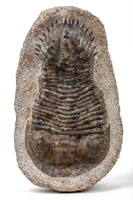 |
Large Spiked Trilobite. Burmeisterella is a very rare large 375 million year old spiked trilobite from Morocco. This large 9 inch long 5 inch wide black trilobite is fully inflated in its original light gray matrix. This large impressive trilobite is completely original with the head, body and tail sections complete along with many of the sharp spikes that covered its entire body. Burmeisterella had spikes on its tower shaped eyes and one of its raised eyes is still preserved. This is an excellent quality specimen as almost no specimen of Burmeisterella has ever found complete with all of the spines intact. $800 - 1,150
View details and enlarged photo
| Unsold |
Lot 1015 |
 |
Rare Sauropod Dinosaur Claw. Bothriospondylus is a rare 150 million year old sauropod that was one of the very first dinosaurs discovered in 1875 by Richard Own in the Majunga Basin of Madagascar. Even though it was discovered in 1875, only a few bones, teeth and a few claws have been found from this 60-70 foot long necked sauropod. This rare 5 inch long (around the curve) 2 inch wide complete rear foot claw is complete except for a small one inch area in the front of the claw that has some restoration. Bothriospondylus is mostly known from its pencil shaped teeth with are far more common than the rare foot claws which are only found on three toes of the back feet. Housed in a 8 x 6" Ryker mount. $1,100 - 1,500
View details and enlarged photo
| Unsold |
Lot 1016 |
 |
Pair Of Fossil Crabs. Archaeoperyon puruvianus was a 25 million year old fossil crab from Argentina. What makes this fossil special is that there are two large crabs the largest being 8 inches and the smaller one 6½ inches long side by side as found in their original 14½ x 5" stone matrix. Both crabs have complete carapaces and large claws with shearing teeth-like projections lining the claws with only the ends of some of the legs missing. Minor repair to crack in matrix that in no way affects fossils. Very unusual to find two crabs together in the same matrix making for an impressive display. Comes with stand. $700 - 1,100
View details and enlarged photo
| Unsold |
Lot 1017 |
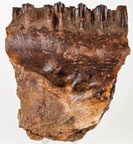 |
Duckbill Dinosaur Partial Maxella Teeth. Edmontosaurus annectens was a very large herbivore that was a favorite food choice for T-Rex. It is known as a Duckbill dinosaur because of its wide toothless beak. Behind the beak were rows of hundreds of replaceable teeth in its back jaw and Maxilla. This 3½ x 4¼ " long section of the Maxilla has 11 original teeth, fragments of replacement teeth and outstanding bone detail. The fragments of the replacement teeth can be seen on the edges of the maxilla. It is 65-67 million years old and was found on a private ranch in the Lance Creek Formation of Niobrara county Wyoming. It comes with a plastic stand for display. $650 - 800
View details and enlarged photo
| Unsold |
Lot 1018 |
 |
4 Colombia Amber Specimens Each with Spiders, Bees, or Dragonflies. 4 amber specimens each about 1 x 2 x ½", from the Colombian rainforest 1-5 million years old. Honey toned amber where the insects trapped are very easy to inspect. Close-up photos of each insect specimen is included. Excellent. $600 - 800
The Geode Shop of Ghost Town, Buena Park.
View details and enlarged photo
| Unsold |
Lot 1019 |
 |
Huge Spinosaurus Dinosaur Tooth. Enormous 80 million year old theropod dinosaur, Spinosaurus, with a huge sail on its back remains an enigmatic dinosaur as no skeleton even remotely complete has been found. Known from its teeth which are fairly common but usually less than two inches long, broken, and ugly, this huge 6.75 inch tooth is the exception having lovely brown colored enamel and a large section of cream colored root. Tooth was found in two pieces with the top two inches of the tip being reattached with some minimal restoration, still fine as one of the largest specimen's known. The enamel of the tooth with tip is 4.5 inches long with a 2.25 inch root section. This rare dinosaur tooth was found in the Kem Kem Valley near Taouz, Morocco. $600 - 800
View details and enlarged photo
| Realized
$588 |
Lot 1020 |
 |
Rare Grouping of Nine Trilobites. This very large 22 x 9½ " black slate slab contains the mass mortality remains of nine trilobites belonging to three different species rarely encountered and missing from most collections. All nine of these white trilobites are 480 million years old from Hunan Province, China and have a white calcite covering which shows up well on the black slate. There are three different species of trilobites present on this slab with the superb 7 inch long specimen being Xiangxiaa, the "hammerhead" shaped heads being Szechuanella and the ones with spines being Asaphinas. All of the trilobites on this rare plate are 3D except for one which was preserved upside down and is recessed into the matrix. $600 - 800
View details and enlarged photo
| Realized
$375 |
Lot 1021 |
 |
Pair of Fine Carcharodon Megalodon Shark's Teeth. Even though largest marine predator in the history of the planet the megalodon's teeth rarely exceeded 4-5". Offered here are a fine pair of fossilize teeth with partial enamel intact, one measures 5" and the other 5¼" and both in excellent condition. Megalodon teeth consistently prove our most popular fossils. $500 - 800
View details and enlarged photo
| Realized
$313 |
Lot 1022 |
 |
Huge Megalodon Shark's Tooth. A very impressive megalodon shark's tooth, the single largest marine predator in the history of the planet. While they could exceed 50 feet in length, their teeth rarely exceeded 4-5". Large teeth are highly prized and this one certainly qualifies. Meausuring 5¾ x 4" tooth has the usual dark brown root and a great percentage of its enamel intact. While remaining natural on the reverse the front has been professionally buffed to a high sheen and makes for a stunning specimen. Comes with lucite stand. $500 - 800
View details and enlarged photo
| Realized
$456 |
Lot 1023 |
 |
Pseudoscorpion in 100 Million Year Old Amber. Many of the insect inclusions in the 100 million year old amber called Burmite found in the Hukawng Valley in northern Burma (Myanmar) are familiar in shape to existing insects but the particular species they represent is now extinct. This clear golden amber cabochon (13 x 10mm) a complete clear Pseudoscorpion about 5mm in size. A Pseudoscorpion is actually an ancient arachnid with pincers that looks like a scorpion. $500 - 700
View details and enlarged photo
| Realized
$408 |
Lot 1024 |
 |
Nice Collection of 10 Fossilized Megalodon Teeth. The largest shark that ever lived on Earth, achieving lengths of more than 50 feet. Teeth found are remarkably small on average. Offered here is a range of fossilized teeth from 1¾ to a nicely sized 4½". All in very good condition exhibiting only minor losses. $500 - 1,000
View details and enlarged photo
| Unsold |
Lot 1025 |
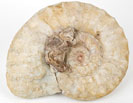 |
Ammonite with Three Oysters Attached. This complete 100 million year old large 10 inch diameter ammonite, Pervenquivia is not only an attractive golden color with excellent detail but it has three oysters, Exogyra sp., attached to it. This is a very rare association fossil where after the ammonite died and its shell settled on the ocean bottom, three oysters attached themselves to its shell and were later buried under the sea bottom and preserved in Grayson County, Texas for the next 100 million years until being dug up. The oysters are a light brown in color and are nicely contrasted against the golden ammonite. $465 - 600
View details and enlarged photo
| Realized
$288 |
Lot 1026 |
 |
Pair of Theropod Dinosaur Teeth Including T-Rex. This lot contains a similar sized tooth from two of the largest carnivorous dinosaurs (40-45 feet long) that ever lived, T-Rex from North America and Charcharodontosaurus from Africa. Even though they looked similar, their teeth are much different in shape. The dark brown 1¾" juvenile T-Rex tooth is more peg-like and better at biting through bone. This complete tooth from Montana just has the usual cracks in the enamel and some serrations with no restoration. The 1½" long and 1 inch wide Charcharodontosaurus tooth is thinner with sharp serrations and better at slicing through flesh rather than bone. This complete tooth from Morocco is a light brown color with most of the enamel intact, good serrations and no restoration. Housed in a 8 x 6" Riker mount. $425 - 600
View details and enlarged photo
| Unsold |
Lot 1027 |
 |
Centipede in Burmite Amber. Excellent quality, clear 1.9 x 1.2 x ¾ mm golden amber color cabochon contains a complete 11mm centipede, a flea larva (3½ mm) and a crane fly larva (3½ mm). Most specimens of Burmite are a dark reddish brown color. Exceptional clear cabochons with classcs amber color are scarce and much more valuable. In a 6 x 5" Riker mount. $425 - 550
View details and enlarged photo
| Realized
$360 |
Lot 1028 |
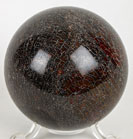 |
Agatized Dinosaur Bone Sphere, Utah, Nice Red Tones. Stunning agatized dinosaur bones fashioned into perfect, highly polished spheres. This particular example boasts deep reds in its complex structures, one of the most sought after colors. Reds, oranges, browns and grays are evident throughout, the craftsmanship, excellent. 3' diameter sphere weighing just at 1½ pounds. $400 - 600
View details and enlarged photo
| Realized
$240 |
Lot 1029 |
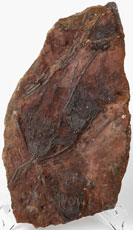 |
Three Large Floating Crinoids. Found in Erfoud, Morocco, this large 16 x 9" slab contains three near complete 475 million year old large Scyphocrinites crowns with exquisite delicate detail and quite large being 3X3, 3X2 and 2X2 inches. These dark brown crinoids still have some of their stems attached to the crowns. Close examination reveals the detailed feather-like feeding arms and small star-shaped calcite stem pieces. There are two other partial crowns and several sections of additional stems. Crinoids are related to star fish and are known as "sea lilies" because they resemble plants more than animals. Scyphocrinites were an interesting floating crinoid with its stem attached to a round air-filled bulb that floated on the surface of the ocean. $400 - 575
View details and enlarged photo
| Unsold |
Lot 1030 |
 |
Triceratops Dinosaur Quadrite Bone. The quadrate bone in Triceratops is the bone between the lower jaw and its massive skull. Interestingly, this bone corresponds to the incus bone (the anvil) in the inner ear in mammals. This rare Quadrate is 15 inches long and 5 inches wide. The bone is complete except for the end of its blade and is a lovely dark brown color with the usual crack repair and a few break repairs. Rarely do dinosaur bones come out of the ground complete pristine condition. Usually, even the best bones are found in a few pieces with some cracks and have to be professionally repaired as was the case with this large famous horned dinosaur bone which was found on a private ranch in the 66-67 million year old Hell Creek Formation of Montana. $400 - 600
View details and enlarged photo
| Unsold |
Lot 1031 |
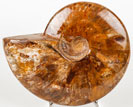 |
Large Madagascar Ammonite. Ammonites were early mollusks that somewhat resembled an octopus or squid living within a protective shell and are the closest relative to the chambered nautilus which still exists today. This large 8 inch diameter 110 million year old ammonite, Cleoniceras was found on the large island of Madagascar. This complete ammonite has its nacre (mother of pearl) polished to reveal its beautiful iridescent beige and brown shell with flashes of red. The only defect is a ½ inch X ½ inch chip in the mother of pearl which only shows on the bottom of the living chamber on one side. Presented on a 4 inch illusion stand for display. $350 - 500
View details and enlarged photo
| Realized
$288 |
Lot 1032 |
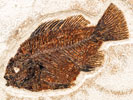 |
Priscara Fish, Museum Quality. Priscacara was an extinct genus of Perch noted for its sharp and stout dorsal and ventral spines. This complete 52 million year old Priscacara is 4¾" long from the Promise Land Quarry of Lincoln County, Wyoming. The fish is complete with all its fins and is a dark brown color. The 12 x 10" limestone matrix has been backed with wood and is ready to be hung if desired with a hanger and wire attached on the back. $325 - 450
View details and enlarged photo
| Realized
$275 |
Lot 1033 |
 |
A Large Nautiloid And A Large Ammonite From Madagascar. Ammonites are the closest relative to the chambered nautilus which still exist today. This lot contains both a large 7 inch in diameter 110 million year old ammonite, Cleaniceras and a 5.75 inch long 110 million year old nautiloid from the large island of Madagascar. Both have been cut in half and polished to reveal the detail and beauty of inner chambers. Ammonites and nautiloids both started growing in the small center and added chambers spiraling outward as they grew. The living animal lived only in the last large chamber and the inner chambers were airtight and could be filled with water by the living ammonite or nautiloid to move up or down in the water. $300 - 400
View details and enlarged photo
| Realized
$384 |
Lot 1034 |
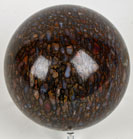 |
Agatized Dinosaur Bone Sphere, Utah, Dazzling Colors. Stunning agatized dinosaur bones fashioned into perfect, highly polished spheres. This particular example boasts an array of colors; rusts, grays, blues and browns evident throughout, the craftsmanship, excellent. 2¾ diameter sphere weighing 1¼ pounds. $300 - 500
View details and enlarged photo
| Realized
$228 |
Lot 1035 |
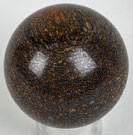 |
Agatized Dinosaur Bone Unusual Colors. Stunning agatized dinosaur bones fashioned into perfect, highly polished spheres. This particular example offers a dazzling medly of pinks, browns, blacks and opaque whites evident throughout, the craftsmanship, excellent. 2½" diameter sphere weighing a bit less than 1¼ pounds. $300 - 400
View details and enlarged photo
| Realized
$204 |
Lot 1036 |
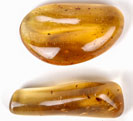 |
Two Large Amber Nuggets With Insects. These two large museum quality clear honey(amber) colored amber nuggets are from Colombia and contain many insects. The first 3½ x 1", 40.6 gram specimen contains more than a dozen insects including several species of flies including two with bright red compound eyes, fleas and a couple of beetles. The second 3½ x 1.8 inch 54.6 gram gem specimen contains several different species of flies, mites and beetles. The absolute age of young Colombian amber or copal cannot be determined as amber itself cannot be tested and dated, but from the quintessential amber color and hardness of these slabs and nuggets, experts suggest their age to be at least 1-5 million years old and probably much older. The insect details are amazing using a magnifying glass. $300 - 400
View details and enlarged photo
| Realized
$192 |
Lot 1037 |
 |
Large Mammal Coprolite. Coprolites are fossilized animal dung and of valuable study to determine what the animal ate and what the temperature and vegetation was like in the area when the dung was fossilized. This very large 6½ mammal coprolite is approximately 12-26 million years old and was found in Lewis County, Washington State One cannot tell which mammal deposited this specimen but by the large size we know that the mammal had to be large such as a cave bear, rhino or other large mammal. Comes with stand. $275 - 375
View details and enlarged photo
| Realized
$150 |
Lot 1038 |
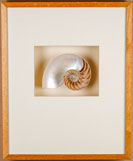 |
Beautifully Shadow Boxed Nautilus Shell. Extremely handsome nautilus shell presented in an expertly shadow boxed display for wall display. 7" in diameter split shell pefectly formed, split to reveal the perfect spiral of chambers. Presented as a signature decor item to be hung, display is matted and boxed in a fine frame of light oak. 22 x 18 x 3½" and in excellent condition. $250 - 350
View details and enlarged photo
| Realized
$150 |
Lot 1039 |
 |
Duckbill Dinosaur Neck Vertebra. This virtually complete 6 x 3¾ x 3½" dinosaur neck vertebra is from a Duckbill Dinosaur that lived in the Two Medicine Formation of Teton County, Montana 70-80 million years ago. Plant-eating Duckbill dinosaurs were named for the duck-like shape of their skulls. All four processes which were the attachments for ligaments and muscle and the central round canal for the spinal cord are very well preserved with the only restoration being re-attaching the processes of the vertebra. Sold with a plastic stand for display. $500 - 650
View details and enlarged photo
| Unsold |
Lot 1040 |
 |
Three Complete Black Russian Ammonites. This 250 million year old completely natural reddish-brown stone block contains three complete 1½ to 2¾" black Russian Ammonites plus several partial ammonites. These unusual black color ammonites also consist of three different species Popanoceras, Marationites and Dolorthoceras. These Permian ammonites are completely natural with no restoration. $350 - 450
View details and enlarged photo
| Unsold |
Lot 1041 |
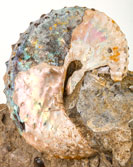 |
Iridescent Scaphite Ammonite. Scaphites are a heteromorphic ammonite which means that for some reason they started out forming the usual spiral shape of ammonites but then began to straighten out. This spectacular complete 75 million year old 2½ x 2¼ "colorful ammonite is on a 4 x 3¾" matrix and comes from the Pierre Shales of South Dakota. This spectacular ammonite still has over 75% of its original mother of pearl that has iridescent pinks, greens and purples with the layer beneath the original outer shell being mostly iridescent green with hints of purple. Ammonites possessing such beautiful iridescent colors are now considered to be a gemstone known as ammonite. These spectacular colors are created by minerals being absorbed in the fossilization process. $350 - 450
View details and enlarged photo
| Unsold |
Lot 1042 |
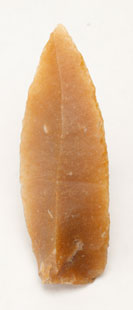 |
Flint Solutrean Point. Superb unifacial projectile point of translucent earth-brown flint in the classic Solutrean, elongated leaf shape. The knapped side bears a raised central spine along the long axis. From the "La Princerie" field across the Creuse River from Grand Pressgny. Ca. 20,000 B.C. 2½" long. Ex: Caldwell Coll., France. $300 - 500
View details and enlarged photo
| Realized
$263 |